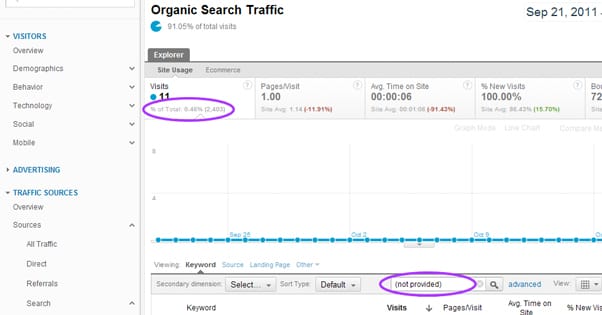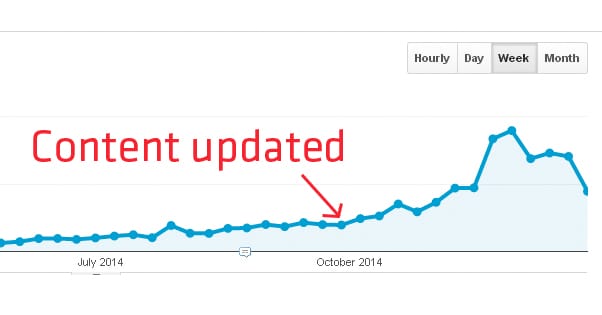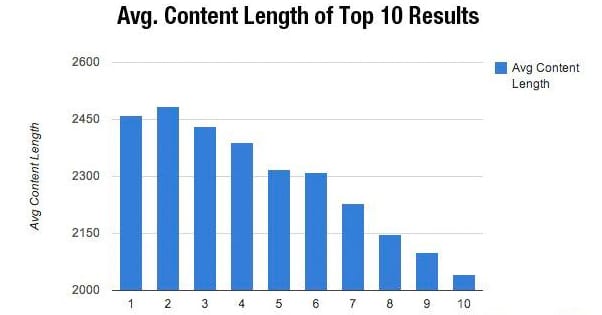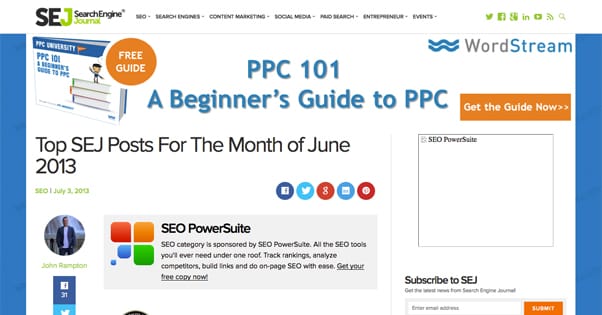How to Breathe Life into Your Old Blog Posts
Published by Kenny Novak • Content Marketing • Posted June 21, 2015 ContentPowered.com
ContentPowered.com
One of the biggest reasons why evergreen content is so in focus in the last few years is because it’s content that lives forever. The alternative – and the content most blogs have for the majority of their content – is content that lives for a few weeks or months before it’s supplanted by something else. After a few years, or half a decade of running a blog, you end up with a ton of old content that’s not really worth anything any more. It might have been valuable in its day, it might be the destination for valuable backlinks, but no one finds it in search and no one reads the content any more.
When a blog fills up with this kind of content, you have a choice on your hands.
- Do you ignore it and keep running your blog like normal?
- Do you delete the least valuable content to raise the quality of your blog overall?
- Do you go back and refresh old posts to make them new and valuable again?
You have options, and I’m going to go over each of them and help you decide.
Remove Ancient Personal Blog Content
First of all, when you’re looking at your ancient blog traffic, you might remember that at some point you were a personal blogger, not a business blogger. This often happens if you’re just a blogger that started writing for fun and eventually leveraged it into a site with ads and sponsors and sold products. You might find a lot of old posts that are poorly written, personal, out of date and valueless.
None of these posts, for sure, have any value you can extract from them.
You can keep them out of sentimentality if you want, though you might consider noindexing them so they don’t come up in searches through your old content. On the other hand, if you find them embarrassing and they have the potential to tarnish your public image, you might as well delete them.
Just remember that nothing is really ever deleted on the Internet. If someone really wants to view an old post, they can always just go to the Wayback Machine and check out the history of your site. Don’t delete content because you want it gone; delete it because it’s not worth keeping.
Remove Content with No Links and No Traffic
A lot of your old content might have been posted before your blog grew to any reasonable size, and the content had time to live and die before you gained such an audience. In the time since, no one has bothered to look at it; it gets 0 hits, it has no incoming links, and it’s not really valuable enough to promote.
This sort of content is basically just dead weight. There’s no reason to keep it. You can if you want, I mean, it’s not doing you any harm. As long as it’s not spammy content, as long as it’s not thin content, and as long as it’s not copied content, it’s fine to keep.
I think there’s one good reason to remove it, though, and that’s blog comments. If you have blog comments enabled, every old post becomes a potential vector for spammers to come in and start leaving their filth on your page. You may as well remove the post so they have one less place to post, and you have one less thing to moderate. Alternatively, you can just disable comments on the post individually, if it’s an option in your blogging platform.
Remove Thin, Poor Quality Content
Back in 2011, Google released the Panda algorithm, and a lot of blogs went through and audited their content then and there. They purged their worst content, bought new content to replace it, and continued skirting the minimum requirements necessary to stay ahead of Google’s changes.
Some other blogs may not have paid attention to Panda as it happened, and are only now getting into SEO enough to have heard about it. The typical reaction is to consider it ancient history and not pay it any mind, and this leads to blogs with a lot of old, thin, and poor quality content.
Back in the day, Google recommended that webmasters delete such content if they couldn’t improve it. Today, I recommend the same thing. Most of this content is going to be valueless, so you might as well get rid of it. Chances are, you’ve been suffering for having it for quite some time, and by removing it, you should see a bump in traffic and rankings.
There are other things you can do with thin content, though, so consider if it has the seeds of value in it before simply deleting it.
Update Potentially Valuable Outdated Content
Often, you will find that you had a valuable piece of information that has since turned into a valueless post simply due to the passage of time. I see this a lot when it comes to guides for various pieces of software, social networks, or CMSs. Whenever a company changes the way something is done, old guides that told you how to do it become valueless. Just take, for example, any old Facebook guide that suggests running a like-gated contest, or talks about tab app landing pages. These features no longer exist.
The thing is, these guides still have reasonable SEO visibility and even some traffic, just because they were at one point the best resource available. The posts might even still get some traffic, but no engagement and no links because the content is out of date.
This kind of content is ripe for a makeover. Take these posts and update them for whatever processes are currently used to do what the post wants to do. This is a great thing to do, because 90% of the work of writing the post is already done. All you need to do is update it and re-promote it, for a second wave of life.
Expand and Update Thin, Poor Content
Remember when I said that some old thin content can be revived in some way, and that you shouldn’t just delete it blindly? This is what I mean. There are two types of thin old content. The first type is the useless fluff that was just written as a gateway page targeting a keyword. This content is garbage and should be deleted.
The other type of thin content is old, valuable content that just happens to be too short to make the cut. This is often the case with simple Q&A style posts. You have a question, you answer the question, it only takes a couple hundred words. To Google, that’s typically thin content. To users, it might be perfectly acceptable, but they don’t see it because Google doesn’t promote it.
There are two methods you can use to buff up this content. The first is to roll it in with other similar posts. This is often used with old FAQ-style posts, where the site published each question on its own page. Merging these pages makes one robust page, which the others can be redirected to. The other option is to figure out how to write more about the topic. Answer the question, give some history behind it, give some examples, make a tutorial about it, and so forth. How, precisely, depends on the content.
Edit Older Content for Modern SEO
One problem with a lot of old content is that it’s perfectly fine, if a little uninspired, but it’s targeting a keyword or keyphrase that is no longer in as much use as it used to be. While it might be decent content, it doesn’t use the keywords necessary to get any search engine visibility in the current age.
The solution to this requires a little bit of work, but it’s not actually difficult. All you need to do is figure out what the old keywords were, then do some keyword research to figure out what new keywords would apply in their place. I’m not advocating a simple find and replace, though. You’re going to have to go in an rewrite your content so the new keywords make sense. You’re essentially repurposing the content for a new phrase.
Once you’ve integrated the new keywords, you’ll need to do another round of promotion for the new post. If you treat it like a new post, rather than a rewritten post, it should have a bit of life left in it.
Update Images, Links, and Headlines for Old Posts
This is more of a supplemental tip that goes along with the other tips on repurposing old content. While you’re in there fixing the text, fix other things about the post as well.
- Old images might not be sized or positioned properly for your blog design, or they might be out of place. You also might not have been aware of image copyright rules when you first made them. In any case, getting new images can go a long way to spicing up an old post.
- Check through all of the links in the post. Make sure the links still lead to relevant destinations, and change them to more relevant posts if necessary. Above all, make sure you’re not linking to parked domains, spam sites, or 404 pages.
- Headlines often change when you change keywords, but if they don’t, consider changing them anyways. A new, catchier title might be just the thing to capture reader attention.
Write Updated Versions and Link From Old Posts
Sometimes your old post had so much presence, and traffic that still continues, that you don’t want to change anything about it for fear of breaking the magic. Instead, a good idea might be to create a new post with the same topic, as an updated guide or study, and then link to the new post from the old post.
I see this particularly in old marketing guides. When a guide to PPC or a guide to blogging reaches a certain age, people become skeptical about its value. Rather than continually assure people that it’s still valid, you can create a new post and add a line to the top of the old one. “The popularity of this post has led us to create a new one, with more tips, better information and a more updated perspective. Check it out!”
Update tutorials for Modern Processes
I’ve mentioned this a bit above, but old tutorials can still bring in a lot of traffic, and their old links can be very valuable. Find these old tutorials and rewrite them to include accurate, up to date instructions. Sometimes all it takes is a few new screenshots. Sometimes it’s a removed feature you need to work around, or a workaround that was made into a real feature. In any case, an old post that maintains a high search ranking is ripe for review.
Find Old Valuable Content and Remake it as an eBook
Ebooks are all the rage these days, and a good ebook can go a long way towards promoting your blog and bringing new visitors in. If you sell it, you can even make a profit off of it.
Now, this is where you’re not precisely doing anything to your old content. In fact, the old, thin, valueless content should be ignored for this project. Instead, you’re looking for the older content that’s still highly relevant and valuable. Any time, for example, you have an old study or guide that still brings in a lot of traffic, think about how you might double or triple the length and value of that guide.
If you can figure out how to add a lot of value, go ahead and do it. You’re essentially creating a bonus version of your old free content. Of course, to have any success with it, you need to go through the whole marketing and promotion cycle for it. It’s not easy, but it can be very valuable, particularly if the content was valuable to begin with.
Promote Old Posts as New Posts
“What about all my old posts that still have a lot of value, traffic, and links?” you ask? Well, there’s a solution for that too; just promote them as if you just posted them! Some blogs don’t have the date of publication listed, but even if yours does, very few people bother to look at the date unless they’re specifically questioning how valid the information is. If your post is valuable but a little old, just give it another round in the old PPC-Facebook-Twitter-promotion machine, and see how it does.
As an added bonus, the post already has links and already has traffic from its initial life.
By promoting it again, you’re riding on the past promotion to make it even better. It’s even better than that if you have comments. One of the hardest parts of promoting a post is getting the first comment, because no one likes being the first poster. If you already had some comments, it’s perfect.
Create Collections of Old Posts
If you have a number of old, valuable posts, here’s an idea; create a new post that links to them. I’m not talking about incidental links, here. None of that subtle linking to an old post as a reference stuff. No, I’m talking about a dedicated “this is the good stuff on my blog” post.
The first step to this is to go to your analytics and identify the top 10 or so posts on your blog.
If you like, you can divide this by year, and come up with the top 5 or 10 posts of each year you’ve been in operation. Create a new post and list each of these posts, with a link, a summary, an analysis of the traffic and why you think it performed so well. Trust me, new bloggers will love this; they love to see examples of what they can do based on what’s popular.
Another variation of this idea is to come up with a list of the top 10 worst posts you’ve written. This is better for a more detailed guide on what went wrong and why those posts didn’t do well. This is an equally interesting and informative study, but it’s not likely to be quite as valuable because it’s not pointing to value itself.
Recreate Old Posts as New Forms of Media
Another way you can breathe life into your old posts is to change their format.
Take an old post and condense it down to just the salient points, then illustrate those points in the form of an infographic. This is great, because infographics are really easy to share and have directories of their own.
You can also take and edit the post into a video or podcast script. A video can be as simple as you talking into a webcam, with some overlaid graphics to illustrate points. Podcasts are easier, because you don’t need to worry about graphics.
Slideshare works the same way as infographics, though you’ll need to create and illustrate individual slides instead of one long graphic. However, it’s easy to pull ahead on Slideshare just by having a compelling and illustrated presentation, as opposed to the text dumps so many other people make.
Redo Old Research for a Changed Perspective
Sometimes old content relies on old data, but the study itself is valid. In these situations, you can take the study methodology and apply new data to come up with new, more up to date conclusions. There are some blogs that do this every year, analyzing certain sets of keywords to see when Google makes a change, or analyzing demographic data to monitor Internet-wide trends. You can do this too; you just need a compelling experiment you can repeat each year, or even every six months, to monitor the way the winds are blowing.











